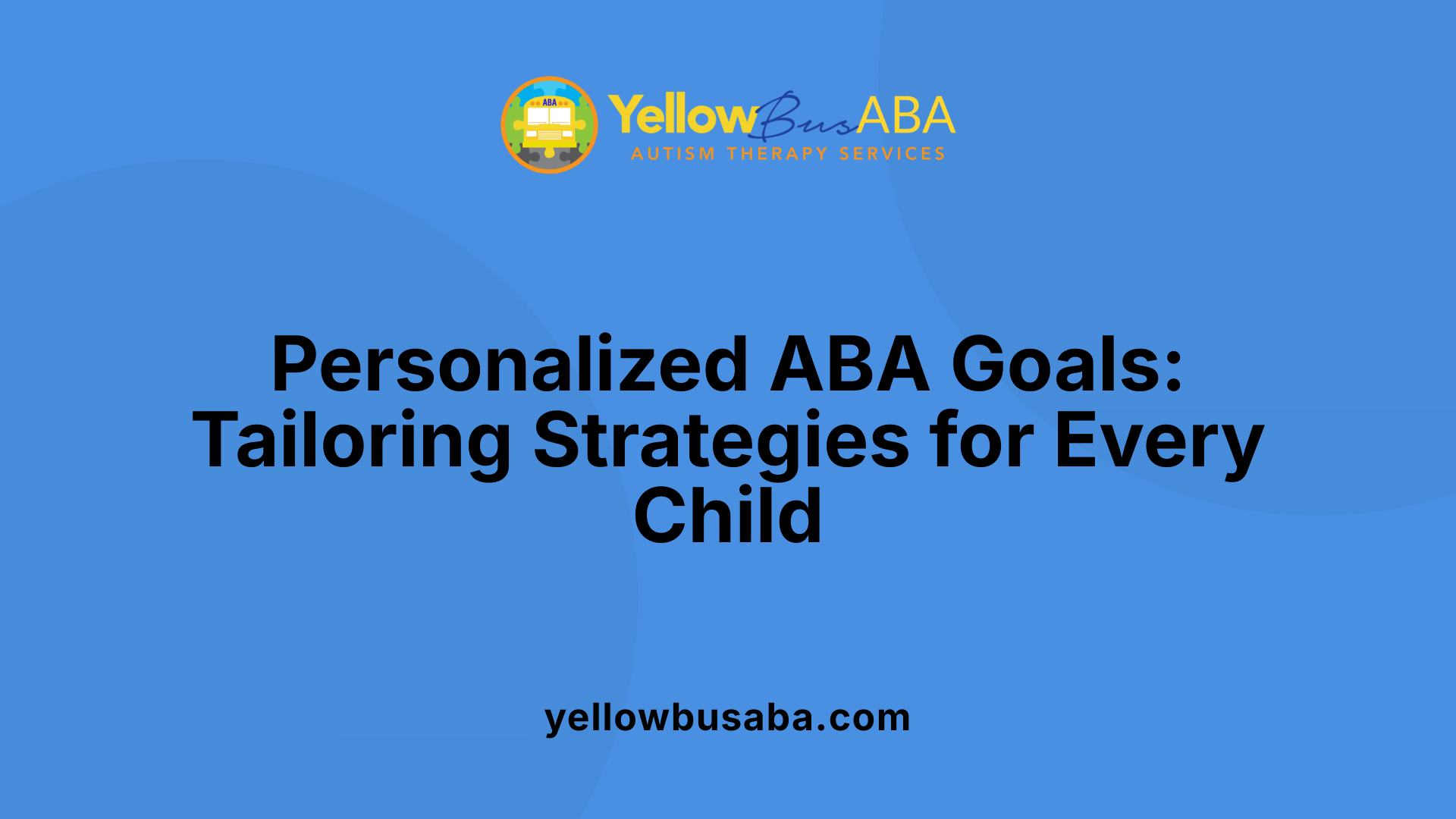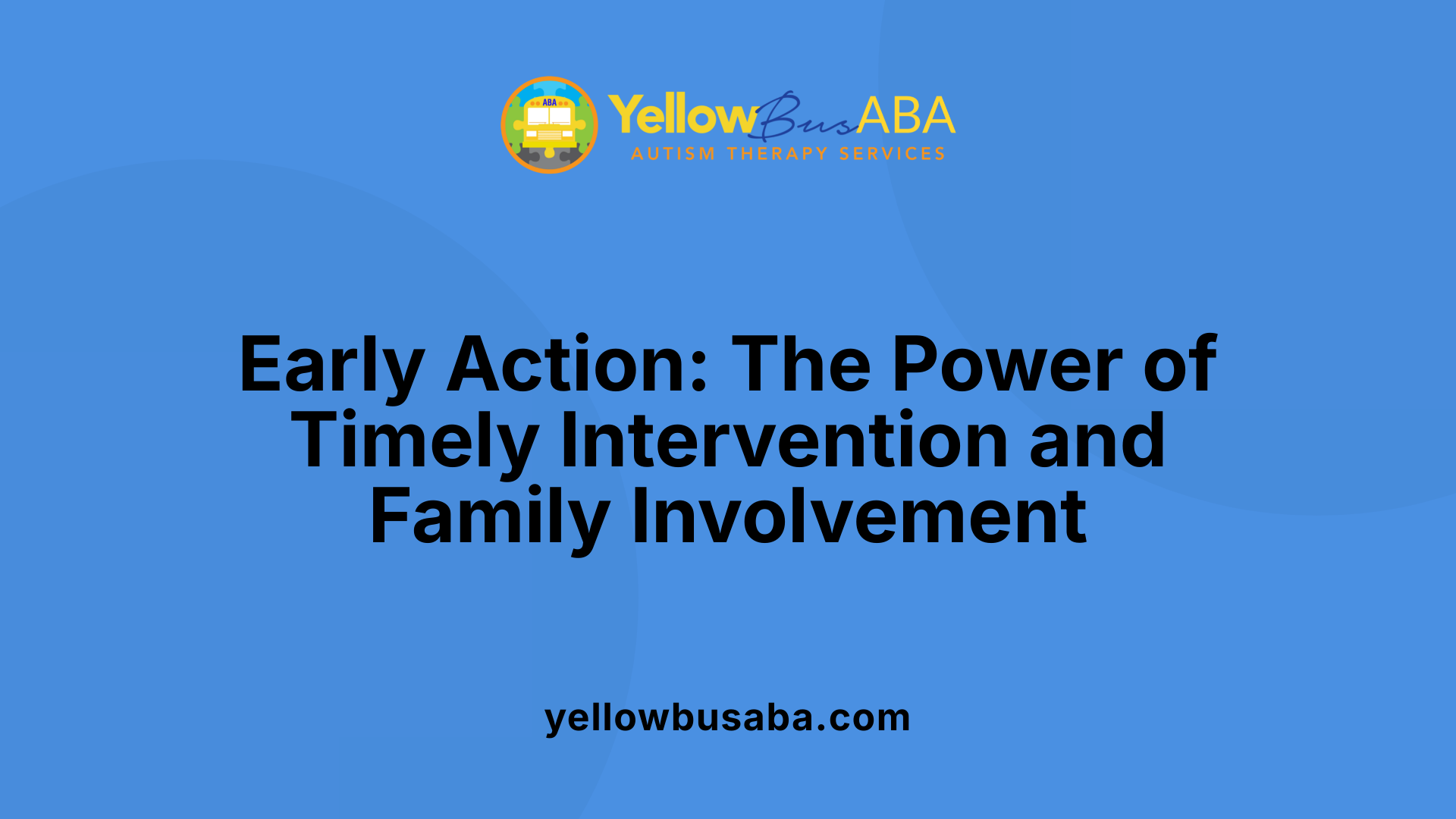How ABA Therapy Helps Children with Autism Achieve Behavioral Goals in a Natural Setting
September 15, 2025
Unlocking Potential: The Role of Naturalistic ABA in Autism Development

Introduction to ABA Therapy for Children with Autism
Applied Behavior Analysis (ABA) therapy is a scientifically supported, highly individualized intervention that has transformed the developmental landscape for children with Autism Spectrum Disorder (ASD). Recognized globally for its effectiveness, ABA employs structured strategies grounded in behavioral science to foster meaningful behavioral and skill improvements in natural settings like home, school, and community environments. Early intervention, often before age five, leverages neural plasticity to maximize outcomes, leading to enhanced communication, social interaction, independence, and overall quality of life for children with autism.
Fundamentals of ABA Therapy: Principles and Process

What are the principles and process of ABA therapy for children with autism?
Applied Behavior Analysis (ABA) therapy is founded on the scientific understanding of how behavior works and how it can be changed through environmental influences. At its core, ABA employs principles such as reinforcement, punishment, and environmental modifications to promote meaningful changes in behavior.
The process begins with an initial comprehensive assessment. This involves observing the child's current behaviors, skills, and challenges through data collection, standardized tests, and caregiver interviews. Functional Behavior Assessments (FBA) are often used to identify triggers for problematic behaviors and understand their purpose for the child.
Based on this assessment, therapists develop a personalized treatment plan with clear, measurable goals tailored to the child's needs. These goals may include enhancing communication, social skills, independence, and reducing challenging behaviors.
ABA employs various techniques like Discrete Trial Training (DTT), Natural Environment Teaching (NET), prompting, shaping, and chaining to teach new skills. For example, DTT breaks skills down into small steps and uses repetition, while NET incorporates learning into everyday activities and play.
A hallmark of ABA is the use of positive reinforcement — providing rewards or consequences immediately after desired behaviors to encourage their occurrence. Conversely, undesired behaviors are addressed by identifying triggers and teaching alternative, functional responses.
Throughout therapy, data collection is ongoing. Therapists meticulously record progress, analyze patterns, and adjust interventions as needed. This data-driven approach ensures that the therapy remains effective and responsive to the child's evolving needs.
Overall, ABA therapy integrates systematic, evidence-based strategies delivered by trained professionals to foster communication, social, and daily living skills. It emphasizes flexibility, consistency, and collaboration with families to promote substantial, generalized improvements in behaviors and development.
Assessment and Customization of Treatment Plans

How does ABA therapy help children with autism achieve behavioral goals?
ABA therapy assists children with autism by setting tailored, measurable goals that guide the intervention process. Initially, thorough assessments—including Functional Behavior Assessment (FBA), skill evaluations, and caregiver interviews—are conducted to understand each child's unique needs, strengths, and developmental level.
These assessments help clinicians break broad developmental areas into specific skills and behaviors, making them easier to teach and monitor. For instance, goals might focus on enhancing communication skills, social interactions, daily self-care routines, or reducing aggressive behaviors.
The intervention employs techniques like positive reinforcement to encourage desired behaviors and strategies such as prompting and chaining to teach complex skills systematically. Data collection throughout therapy tracks progress, allowing therapists to analyze what works and adjust strategies accordingly.
Collaboration with parents, teachers, and caregivers ensures that goals remain relevant across different environments. This partnership promotes consistency and skill generalization, enabling children to apply their learning in real-life settings.
Overall, ABA therapy's tailored plans are dynamic, evolving with the child's development. This approach maximizes the chances of achieving behavioral milestones, fostering independence, and improving overall quality of life.
What methods and techniques are used in ABA therapy for children with autism?
ABA therapy utilizes a range of research-backed methods to help children develop crucial skills and manage behaviors. Each technique is selected based on the child's individual needs and the specific goals of therapy.
One commonly used method is Discrete Trial Training (DTT), where skills are broken into small steps, then taught through repeated trials with reinforcement for correct responses.
Natural Environment Teaching (NET) capitalizes on everyday activities and natural settings, making learning more relevant and promoting generalization.
Pivotal Response Treatment (PRT) emphasizes motivation and child-initiated activities within play, aiming to impact multiple developmental areas through pivotal behaviors.
Additional techniques include prompting and fading, which support independence by gradually reducing assistance; behavior chaining to teach complex sequences like dressing or brushing teeth; and visual supports to enhance understanding.
Reinforcement strategies are fundamental, with positive reinforcement used to motivate behaviors and sometimes extinction methods employed to reduce problematic behaviors. Skills are often taught using visual modeling, social skills training, and script fading to improve interaction and communication.
Overall, these varied methods work together within a comprehensive ABA framework to support skill acquisition and behavior reduction in children with autism.
Teaching Skills in Natural Environments
How does ABA therapy promote skill development and behavioral improvements in real-life environments?
ABA therapy enhances children’s skills and reduces behavioral challenges primarily through Natural Environment Teaching (NET) and play-based learning. These approaches use everyday routines and child-led interactions to teach functional and socially meaningful skills where children naturally encounter them. By integrating teaching moments within daily activities—like mealtime, playtime, or community outings—therapists help children practice behaviors in contexts they will use regularly.
Reinforcement plays a crucial role, provided during authentic situations to motivate children and encourage the repeated use of desired behaviors. For example, a child might be encouraged to request a toy using words or gestures during play. This real-life application reinforces learning and builds motivation.
Play-based ABA approaches embed therapeutic tasks into fun activities, strengthening engagement and fostering positive relationships. These methods make learning more natural, which increases the likelihood that children will transfer skills across settings.
Overall, using natural routines and play-based strategies aligns with how children learn best—through meaningful, contextually relevant experiences. As a result, children gain independence, improve their social interactions, and develop behaviors that are useful in everyday life, leading to lasting improvements in behavior and function.
What outcomes and milestones can be expected from ABA therapy for children with autism?
Children undergoing ABA therapy can expect a wide range of developmental achievements tailored to their individual needs. Key milestones often include improved communication abilities such as requesting items, labeling objects, and responding to questions. These foundational skills help children express needs more effectively, reducing frustration and challenging behaviors.
Social skills also see marked progress; children learn to make eye contact, share, take turns, and understand social cues like facial expressions and body language. These skills foster better social interactions and relationships.
In terms of daily living, many children achieve independence in activities such as toileting, dressing, grooming, and eating. These improvements contribute significantly to their autonomy and confidence.
Behaviorally, ABA helps reduce problematic behaviors such as tantrums, aggression, or self-injury by identifying triggers and teaching alternative, functional communication responses.
Cognitive and academic skills, including following instructions, matching, sorting, counting, and recognizing letters and numbers, also improve as part of comprehensive therapy.
All progress is carefully tracked through data collection, enabling therapists and families to tailor interventions further and ensure skills are generalized across different environments—home, school, and community. The ultimate goal is to support each child's growth, independence, and quality of life, making learning relevant and meaningful in their everyday experiences.
Impact of Early Intervention and Family Collaboration

Why is early intervention important in ABA therapy?
Early intervention, particularly when initiated before the age of five, plays a crucial role in optimizing outcomes for children with Autism Spectrum Disorder (ASD). During this critical period of neural plasticity, children are highly receptive to learning new skills, and early ABA therapy can significantly improve communication, social interaction, and independence. The earlier a child begins targeted interventions, the better their chances for acquiring essential skills that support long-term development. Research consistently shows that early ABA therapy leads to substantial gains in cognitive, behavioral, and adaptive skills, setting a strong foundation for future success.
How does parent training and involvement influence therapy?
Parents are integral to the success of ABA programs. Training caregivers to implement strategies, reinforce skills, and manage challenging behaviors ensures consistency across different environments like home and school. Parent involvement not only enhances skill generalization but also boosts the child's motivation and comfort, as familiar routines and positive reinforcement foster learning. Active collaboration between therapists and families allows for seamless integration of therapy goals into daily routines, making interventions more effective. Regular communication, shared goal setting, and ongoing training empower parents to support their child's progress and sustain gains over time.
What role do caregiver support and community networks play?
Supporting families emotionally and practically is vital in maintaining the benefits of ABA therapy. Caregivers often face challenges balancing therapy responsibilities with daily life, so access to community resources like parent groups, support organizations, and informational networks helps reduce stress and promote resilience. Sharing experiences and strategies within these networks offers emotional comfort and invaluable insights, encouraging continued engagement with therapy. Furthermore, community programs facilitate socialization opportunities for children, enhancing social skills and reducing feelings of isolation for families. Overall, a strong support system fosters a positive environment for sustained development and well-being.
| Aspect | Details | Additional Notes |
|---|---|---|
| Early Intervention | Begins before age five to leverage neural plasticity | Significant improvements in communication and social skills |
| Parent Training | Caregivers learn to implement ABA strategies | Enhances generalization and consistency |
| Family Support | Emotional and practical assistance from networks | Reduces stress and promotes sustained progress |
| Community Resources | Support groups, community programs | Foster socialization and community engagement |
| Therapy Effectiveness | Varies with treatment intensity, personalization | Ongoing assessments adapt goals for optimal results |
What factors influence the effectiveness of ABA therapy for children with autism?
The success of ABA therapy hinges on several factors. First, the intensity and duration of treatment are critical; higher hours per week and early commencement usually correlate with greater developmental gains. Personalized, data-driven plans tailored to the child's unique strengths and needs maximize effectiveness by focusing on relevant goals. The degree of family involvement and collaboration with trained professionals enhances consistency, a central element in successful therapy. Additionally, the child's age at intervention onset and initial functioning levels can significantly impact results—children starting earlier tend to show more substantial improvements. Continuous progress monitoring allows for adjustments to therapy plans, optimizing outcomes. Ethical practices and cultural sensitivity further support effective, sustainable intervention.
Addressing Behavioral Challenges and Promoting Independence
How does ABA therapy help children with autism achieve behavioral goals?
ABA therapy supports children with autism by establishing clear, personalized, and measurable behavioral targets. This process begins with comprehensive assessments, including functional behavior assessments (FBA), skill evaluations, and caregiver interviews. These assessments inform the creation of tailored treatment plans that specify specific actions, such as reducing tantrums or increasing communication.
Therapists break down complex skills into small, manageable steps and use reinforcement strategies like praise, rewards, or preferred activities to encourage desired behaviors. They systematically teach children new skills—ranging from requesting and labeling to social interactions and daily routines—while teaching strategies to replace problematic behaviors with functional alternatives.
Progress tracking is essential. Therapists collect data regularly to monitor behavioral improvements and adjust interventions accordingly. Collaboration with families and caregivers ensures that skills learned in therapy sessions are generalized across home, school, and community settings, increasing the likelihood of sustained progress.
What outcomes and milestones can be expected from ABA therapy for children with autism?
Children undergoing ABA therapy typically show marked improvements in communication, social skills, and behaviors. Early milestones include the ability to request needs, label objects, establish eye contact, and respond to social cues. As therapy progresses, children often gain independence in self-care routines such as toileting, dressing, and grooming.
Behavioral milestones also include reducing problematic behaviors like aggression, self-injury, or tantrums. These are achieved by identifying triggers and teaching children appropriate replacement behaviors—such as functional communication—to express their needs.
Throughout therapy, progress is consistently evaluated through detailed data collection and ongoing assessments. This enables personalized adjustments, ensuring that children advance towards experienced milestones. Over time, children's skills generalize across different settings, facilitating greater participation in daily activities, social environments, and educational contexts.
What are the benefits of ABA therapy for children with autism?
ABA therapy offers numerous advantages that significantly impact a child's development and quality of life. It helps children acquire essential communication skills, including both verbal and augmentative methods such as sign language or communication devices. This improved communication often leads to better social interactions and stronger relationships.
The therapy also emphasizes behavior reduction, decreasing harmful or disruptive behaviors such as aggression, self-injury, or tantrums. As children learn to self-regulate and communicate effectively, they become more independent in daily living tasks like dressing, grooming, and toileting, which boosts confidence and autonomy.
Early and consistent ABA intervention promotes academic success by teaching foundational skills such as matching, sorting, and following instructions. These skills support continued learning and social participation.
Finally, ABA therapy enhances family bonds by empowering caregivers with strategies to support their child's ongoing development. It creates a supportive framework that fosters long-term benefits, including improved social, emotional, and cognitive outcomes into later childhood and adulthood.
The Role of Caregivers and Support Networks

How can parents and caregivers support their child's progress in ABA therapy?
Parents and caregivers are integral to the success of ABA therapy. Their involvement extends beyond family routines into active participation and collaboration with therapists. By learning specific ABA techniques through training sessions, caregivers can effectively apply these methods at home to reinforce skills and behaviors learned during therapy sessions.
Integrating ABA strategies into daily activities, such as prompting communication requests, encouraging social interactions, and practicing independence tasks, helps children generalize skills across different settings. Consistent reinforcement and positive feedback at home can significantly accelerate progress.
Maintaining open communication lines with therapists ensures that goals remain aligned and that adaptation to changing needs occurs. Setting clear, manageable goals together and tracking progress through data fosters motivation and accountability.
Creating a structured and predictable environment at home supports learning. Using visual schedules, giving clear instructions, and applying reward systems motivate children and help build routines.
Support networks such as parent groups, online communities, and community organizations are also vital. These groups provide emotional support, shared experiences, and practical advice.
Participation in local support groups encourages caregivers to exchange strategies, celebrate successes, and discuss challenges. Many organizations offer workshops and informational sessions, equipping families with tools for effective support.
Such networks promote resilience, reduce feelings of isolation, and create a community atmosphere that benefits both children and families.
What is the importance of ABA therapy in supporting behavioral and developmental progress in children with autism?
ABA therapy is a scientifically validated approach that has demonstrated significant benefits for children with autism. It supports developmental progress by teaching essential skills such as communication, social interaction, and daily living activities.
This therapy is personalized, addressing each child's unique needs and strengths through data-driven techniques like positive reinforcement and behavior analysis. Early intervention and consistent, long-term therapy are associated with better outcomes, including increased independence and improved quality of life.
Focusing on real-world settings, ABA helps children apply learned skills broadly across home, school, and community environments. It promotes meaningful participation, social inclusion, and self-sufficiency.
Overall, ABA empowers children with autism by nurturing their growth in critical areas, helping them reach their full potential and enhancing their overall well-being.
What support networks are beneficial for families of children with autism undergoing ABA therapy?
Support networks are essential resources that help families navigate the complexities of autism and ABA therapy. Parent groups and community organizations connect families with shared experiences, offering emotional comfort and practical advice.
These networks facilitate peer-to-peer support, reducing feelings of isolation and providing a platform for exchanging tips on managing behaviors, advocating for services, and reinforcing learning strategies at home.
Educational workshops, seminars, and resource-sharing events are often available through local or national organizations. Such activities empower caregivers with knowledge about autism and effective intervention techniques.
Online forums and social media groups further extend support, allowing families to ask questions, seek advice, and build friendships regardless of geographic location.
Participating in these networks boosts resilience and provides a sense of community, which is crucial for sustained engagement with therapy and overall family well-being.
Overview of How Caregiver Support and Networks Impact Therapy Success
| Aspect | Benefit | Details | |----------------------|---------------------------------------------------------------|------------------------------------------------------------------------| | | Caregiver Training | Enhances skill reinforcement at home | Proper application of ABA strategies leads to consistent learning | | Family Involvement | Promotes generalization of skills | Reinforces skills across environments, accelerating progress | | Support Networks | Provides emotional and informational support | Shares experiences, reduces stress, and fosters resilience |
Effective caregiver involvement, aided by strong community support, creates an environment conducive to continuous progress. Such engagement ensures that therapy is a collaborative effort, culminating in better developmental outcomes for children with autism.
Using ABA Strategies to Support Sensory Integration and Behavior Management
What techniques are used in ABA to address sensory sensitivities?
ABA therapy employs several targeted strategies to support children with sensory sensitivities. One such method is desensitization, which involves gradually exposing children to sensory stimuli to help reduce anxiety or over-responsiveness. This approach allows children to become accustomed to sensory input at a manageable pace.
Another important technique is sensory diets. These are personalized activity plans that incorporate activities such as swinging, deep pressure, or certain textures, designed to help regulate sensory input and foster emotional stability.
Creating sensory-friendly environments is also a core aspect of ABA intervention. This might include reducing loud noises, adjusting lighting, or providing calming spaces at home, school, or community settings.
Additionally, teaching coping and self-advocacy skills enables children to communicate their sensory needs and seek comfort or adjustments when overwhelmed. Such skills empower children, helping them manage their sensitivities proactively.
Integration of these techniques into ABA plans aims to support emotional regulation, decrease problematic behaviors triggered by sensory overload, and ensure children can participate more fully in daily life.
What benefits are gained from ABA interventions focusing on sensory integration?
Focusing ABA interventions on sensory integration can bring substantial benefits to children with autism. These strategies help children better manage their sensory sensitivities, leading to improved emotional control and a reduction in challenging behaviors like tantrums, meltdowns, and self-injury.
Children become more comfortable in diverse environments, allowing full participation in social, educational, and community activities. This enhances their learning experiences and social interactions.
Moreover, teaching coping mechanisms and advocacy skills enables children to effectively communicate their needs, boosting independence and confidence in various settings.
Overall, sensory-focused ABA practices foster resilience and adaptability, supporting children in handling sensory-rich environments more effectively. These improvements contribute to better quality of life, emotional well-being, and long-term developmental progress.
| Technique | Description | Impact |
|---|---|---|
| Desensitization | Gradual exposure to sensory stimuli | Reduces anxiety and over-responsiveness |
| Sensory Diet | Personalized sensory activity plan | Regulates sensory input for better emotional control |
| Sensory-friendly Environments | Adjusted physical environment | Minimizes overwhelm and promotes comfort |
| Coping & Advocacy Skills | Teaching communication of sensory needs | Empowers children and promotes independence |
Search Query: sensory integration ABA strategies autism
Using these evidence-based techniques, ABA therapy supports children with sensory sensitivities by fostering better emotional regulation, decreasing problem behaviors, and encouraging meaningful participation in daily activities across settings. Properly tailored plans, caregiver collaboration, and ongoing assessment ensure these strategies effectively meet each child's unique sensory profile and developmental goals.
Ensuring Skills Generalization and Long-term Success
How does ABA therapy promote skill development and behavioral improvements in real-life environments?
ABA therapy effectively fosters skill development and positive behavioral changes by emphasizing naturalistic teaching methods. Natural Environment Teaching (NET) and play-based strategies are at the core of this approach. These techniques focus on integrating learning into daily routines and child-led interactions within natural settings such as home, school, and community.
By embedding lessons into familiar contexts, children are motivated to use new skills in real-life situations. Reinforcements are provided during authentic activities, which encourages children to practice behaviors that are socially relevant. For instance, a child might learn to request using a picture exchange system during play or mealtime, directly applying the skill at home or in social settings.
Play-based ABA techniques enrich this process by making therapy enjoyable, boosting engagement, and strengthening relationships. As children become more comfortable, they transfer learned behaviors naturally across various environments, thus promoting independence and social integration. These methods help children adapt routines like dressing, toileting, or communicating into everyday life, leading to meaningful and lasting improvements.
What strategies are most effective in ensuring skill generalization across different settings for children with autism?
Achieving generalization of skills requires deliberate strategies that connect therapy to everyday life. A primary method is teaching in multiple environments, allowing children to practice behaviors in different settings, such as at home, school, and within community activities.
Involving family members, teachers, and caregivers in the intervention process is crucial. Training parents and educators ensures consistency in how behaviors are reinforced and prompts delivered, creating a seamless support system outside therapy sessions.
Creating routines that mirror real-world situations also plays a significant role. For example, practicing social greetings during a snack time or requesting items during a shopping trip helps children learn skills in relevant contexts.
Therapists continually monitor progress through data collection and regular assessments. This ongoing process allows for adjustments, like modifying prompts or reinforcement strategies, to ensure children can apply skills broadly. Using varied response formats and reinforcement schedules across different environments increases the likelihood that new behaviors will be maintained and generalized.
How is progress monitored and adjusted in ABA therapy?
Progress in ABA therapy is closely tracked through systematic data collection. Therapists document behaviors, skill acquisition, and response to interventions during each session. This detailed information highlights areas of success and identifies behaviors needing further support.
Data analysis allows for objective evaluation of the child's development over time. If progress stalls or regression occurs, therapists adjust treatment plans accordingly, such as increasing prompt levels, modifying reinforcement strategies, or integrating new teaching methods.
Regular reviews—often conducted weekly or monthly—are essential to ensure therapy remains aligned with the child's evolving needs and developmental goals. These assessments also help in setting new, achievable objectives and breaking down complex skills into smaller, manageable steps.
In addition to quantitative data, ongoing caregiver feedback enriches the understanding of how skills are transferred to natural settings outside therapy. This collaborative approach ensures continual improvement, promoting sustained gains in communication, social behavior, and daily living skills.
| Strategy | Application | Effectiveness | Additional Notes |
|---|---|---|---|
| Natural Environment Teaching (NET) | Teaching skills in real-life contexts like home, school, community | Enhances motivation and real-world applicability | Integrates seamlessly with daily routines |
| Caregiver and Educator Training | Training for those involved in the child's daily life | Ensures consistency and reinforcement | Critical for generalizing skills outside therapy |
| Routine and Context Variation | Practice in diverse environments and situations | Facilitates flexible application of skills | Reinforces learning across settings |
| Data-Driven Adjustments | Regular collection and analysis of progress | Guides modifications in intervention | Ensures therapy adapts to child's needs |
By combining these strategies with continuous monitoring, ABA therapy maximizes the likelihood that children with autism will successfully transfer new skills across various settings, supporting their long-term growth and independence.
Monitoring Progress and Making Adjustments
What are the factors that influence the effectiveness of ABA therapy for children with autism?
The success of ABA therapy is shaped by various factors that work together to determine how well a child responds to treatment. One of the most significant is the intensity and duration of therapy. Generally, more hours per week and early intervention—starting before age five—are associated with better developmental outcomes.
Another vital element is how personalized the therapy plan is. Tailored programs that use ongoing data collection to adapt to each child's unique needs tend to be more effective. These plans include specific goals related to communication, social skills, behavior reduction, and daily living skills.
Family involvement plays a crucial role. When parents and caregivers actively participate in the therapy process, reinforce learned skills at home, and work closely with trained professionals, progress tends to accelerate. Consistency across different environments such as home, school, and therapy settings supports skill generalization.
Children’s age at the start of therapy also influences how much they can benefit. Younger children often show rapid progress, especially when intervention services are intensified during critical developmental periods. Additionally, pre-intervention functioning levels, such as initial communication abilities and social skills, impact how quickly improvements occur.
Regular assessment through data analysis helps pinpoint what strategies are most effective for each child. When therapy plans are adjusted based on these assessments, it ensures that interventions remain aligned with evolving developmental needs.
Lastly, ethical practices and cultural sensitivity are important considerations. Respecting the child's individual background and maintaining ethical standards in treatment foster a supportive environment conducive to progress.
How does ongoing data collection support therapy adjustment?
Data collection is fundamental to evidence-based ABA intervention. By systematically recording behaviors, responses to reinforcers, and skill acquisition, therapists can observe trends and measure progress objectively.
This continuous monitoring allows for timely modifications to treatment plans. For example, if a child is not responding to a specific reinforcement or prompting strategy, the data can reveal this insight, prompting a shift to different techniques.
Moreover, tracking specific behaviors like tantrums, eye contact, or communication attempts helps identify triggers and effective replacement behaviors. Data-driven decisions help optimize learning, prevent stagnation, and ensure that goals remain relevant and attainable.
How are goals reviewed and strategies recalibrated?
Regular review sessions are scheduled to analyze collected data and evaluate progress towards established goals. These goals, often formulated as SMART (Specific, Measurable, Achievable, Relevant, Time-bound) objectives, provide clear benchmarks for success.
During reviews, therapists, parents, and caregivers discuss achievements and challenges. If a goal is met ahead of schedule, new skills or more complex tasks are introduced. Conversely, if progress is slower than expected, strategies are revisited, and supports are intensified or modified.
This adaptive approach maintains a child's motivation and prevents frustration or disengagement. It also respects the dynamic nature of development, ensuring that therapy evolves to meet current needs.
What strategies are used to adapt ABA therapy plans?
Adaptation involves several strategies, including:
- Adjusting reinforcement schedules to maintain motivation.
- Incorporating new teaching methods such as Natural Environment Teaching (NET) or Pivotal Response Treatment (PRT) based on observed effectiveness.
- Breaking down complex skills into smaller, manageable steps.
- Modulating session lengths and frequency to fit the child's attention span and endurance.
- Fostering generalization by practicing skills across different settings and with various people.
All adaptations are guided by ongoing data analysis to ensure they meet the child's evolving needs. This flexible, responsive approach is essential in maximizing therapy outcomes.
| Aspect | Action | Expected Outcome |
|---|---|---|
| Data Collection | Track behaviors and responses continuously | Detect patterns, inform adjustments |
| Goal Review | Regularly assess goal attainment | Ensure goals remain relevant and challenging |
| Plan Modification | Recalibrate strategies based on data | Improve engagement and skill acquisition |
| Family Collaboration | Involve caregivers in planning and review | Reinforce skills, enhance consistency across environments |
| Cultural and Ethical Sensitivity | Respect individual backgrounds during intervention | Promote sustainable, respectful therapy |
By combining meticulous data collection with flexible plan adjustments and collaborative review, ABA therapy continually aligns itself with each child's developmental journey, maximizing the chance for meaningful progress.
Integrating Family and Community Support for Long-Term Success

Why is caregiver involvement so important in ABA therapy?
Caregiver involvement is a cornerstone of effective ABA therapy. When parents, guardians, and family members actively participate in the therapy process, it ensures that the strategies and skills learned during sessions are reinforced at home and in everyday situations. Caregivers help reinforce positive behaviors, implement strategies consistent with the therapy plan, and provide ongoing motivation.
Furthermore, family participation enhances the child’s comfort and engagement, making it easier to generalize learned skills across various settings. Training and guidance from therapists empower caregivers to apply techniques like prompting, reinforcement, and modeling effectively. Their insights also allow therapists to tailor interventions to fit the child’s unique environment, increasing the likelihood of meaningful progress.
Involving families from the outset fosters a collaborative approach, creating a supportive environment that champions the child's development and well-being. This partnership can significantly accelerate skills acquisition and reduce behavioral challenges by maintaining consistency and structure outside therapy sessions.
What community resources and peer networks are beneficial for families of children with autism undertaking ABA?
Support networks and community resources play a vital role in supporting families through their ABA journey. Parent groups, community organizations, and online forums create spaces for sharing experiences, acquiring practical advice, and accessing valuable resources.
These networks help lessen feelings of isolation by connecting families with others facing similar challenges. Through shared stories and mutual support, caregivers find encouragement and emotional relief, which is critical for their well-being.
Many organizations offer training workshops, informational sessions, and resources on navigating ABA therapy and advocating for their children’s needs. These programs often include strategies for managing behaviors, incorporating therapy techniques into daily routines, and fostering communication and social skills.
Peer networks also facilitate advocacy efforts, help families understand their rights, and promote awareness about autism and available services. Community involvement can lead to better access to services, improved social integration for children, and a more inclusive environment.
Support networks beneficial for families
| Support Network Type | Description | How It Helps |
|---|---|---|
| Parent Support Groups | Local or online communities of parents | Share experiences, provide emotional support, exchange practical strategies |
| Community Organizations | Nonprofits and local agencies | Offer resources, workshops, therapy options, and advocacy support |
| Online Forums & Social Media | Virtual spaces dedicated to autism support | Facilitate peer advice, resource sharing, and connection regardless of location |
| Educational Workshops & Seminars | Organized events by professionals | Provide training on ABA techniques, behavior management, and advocacy |
| Professional Counseling | Therapists specialized in family support | Offer emotional support, counseling, and guidance to reduce stress and improve family dynamics |
How does support at home and in the community promote long-term benefits?
Consistent support across home and community settings ensures that children with autism develop comprehensive skills that endure over time. Families who actively participate in therapy and utilize community resources help children generalize skills beyond structured sessions.
This consistency leads to improved social interactions, better problem behavior management, and increased independence in daily living skills. It also nurtures a positive environment that promotes confidence and emotional resilience, benefiting the child’s overall development.
In the long run, such comprehensive support can lead to higher academic achievement, better integration into social and community activities, and more successful transitions into adulthood. It also empowers families to become advocates and active participants in their child's developmental trajectory.
Encouraging community engagement and family collaboration
Integrating family efforts with community resources creates a broad network of support. This approach not only reinforces the child's skills but also provides caregivers with valuable knowledge and emotional sustenance.
Attending local support groups, participating in community events, and connecting with other families create a shared sense of purpose and solidarity. Such engagement motivates families to be proactive in seeking resources, services, and opportunities for their children.
Ultimately, a cohesive support system that bridges home, therapy, and community environments fosters sustained developmental gains and enhances the child’s quality of life. Active collaboration among parents, community organizations, and professionals ensures that children with autism receive a consistent, well-rounded foundation for growth and success.
Conclusion: The Transformative Power of Naturalistic ABA Interventions
ABA therapy, particularly within natural settings, stands as a cornerstone in supporting children with autism to achieve their behavioral and developmental milestones. Its personalized, evidence-based strategies foster critical skills, reduce challenging behaviors, and promote independence across various environments. Early intervention combined with active involvement of families and caregivers ensures sustained progress and improved quality of life. Emphasizing naturalistic teaching methods such as NET and play-based learning enhances real-world application, making the skills more meaningful and durable. As research continues to support the efficacy of ABA, ongoing collaboration among professionals, families, and communities remains vital to unlocking the full potential of every child with autism.
References
- What Does ABA Therapy For Toddlers Look Like - Achieve Beyond
- Key ABA Therapy Milestones: What Progress Looks Like
- How to Create Measurable ABA Goals in Autism Therapy
- Uncovering the Benefits of ABA Therapy for Autism
- What Is ABA Therapy? - C.A.B.S. Autism & Behavior Specialists
- 7 Essential Rules of ABA Therapy You Should Know |
- What is ABA Therapy? An In-depth look






